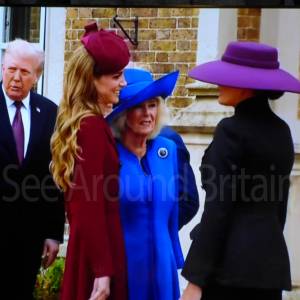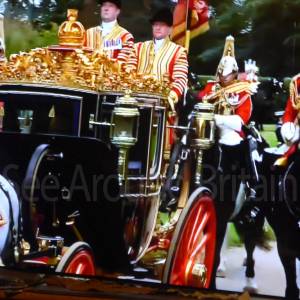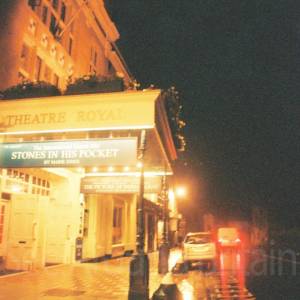Windsor Castle, Windsor, Berkshire. Open Thursday to Monday. Paid Admission.
Details
Accessibility
The Castle's Accessibility Guide can be found on the Home page of the website HERE.
"Windsor Castle is accessible. Concessionary rates are available if you have a disability and a free access companion ticket can be obtained by contacting the Specialist Sales Team on +44 (0)303 123 7324 or by emailing specialistsales@rct.uk.
The Castle is situated at the top of a steep hill, long distances have to be covered and much of the site is outdoors. You may wish to download a photo journey (PDF) to help you plan your visit. For travel information, see the section on our mobility page.
An accessible café, toilets, and a Changing Places are available.
Registered assistance dogs are welcome and a number of Wardens are Dementia Friends, please ask staff for any assistance.
The multimedia guide is available in British Sign Language (BSL) and with subtitles.
General information on visiting is available on our Practical Information page.
For detailed access information, please select one of the options below. For any other information, you can contact the Specialist Sales team on +44 (0)303 123 7324 or by emailing specialistsales@rct.uk.
For detailed access information on visiting the local area please see AccessAble's guide to the Royal Borough of Windsor and Maidenhead. "
Brief description
Royal Residence of UK Monarchy and is the largest occupied castle in the world.
Our photographs show the interior of the Castle during the State Visit in September 2025 by US President Donald Trump.
https://en.wikipedia.org/wiki/Windsor_Castle
"Windsor Castle is a royal residence at Windsor in the English county of Berkshire, about 25 miles (40 km) west of central London. It is strongly associated with the English and succeeding British royal family, and embodies almost a millennium of architectural history.
The original castle was built in the 11th century, after the Norman invasion of England by William the Conqueror. Since the time of Henry I (who reigned 1100–1135), it has been used by the monarch and is the longest-occupied palace in Europe. The castle's lavish early 19th-century state apartments were described by the art historian Hugh Roberts as "a superb and unrivalled sequence of rooms widely regarded as the finest and most complete expression of later Georgian taste".[1] Inside the castle walls is the 15th-century St George's Chapel, considered by the historian John Martin Robinson to be "one of the supreme achievements of English Perpendicular Gothic" design.[2]
Originally designed to project Norman dominance around the outskirts of London and oversee a strategically important part of the River Thames, Windsor Castle was built as a motte-and-bailey, with three wards surrounding a central mound. Gradually replaced with stone fortifications, the castle withstood a prolonged siege during the First Barons' War at the start of the 13th century. Henry III built a luxurious royal palace within the castle during the middle of the century, and Edward III went further, rebuilding the palace to make an even grander set of buildings in what would become "the most expensive secular building project of the entire Middle Ages in England".[3] Edward's core design lasted through the Tudor period, during which Henry VIII and Elizabeth I made increasing use of the castle as a royal court and centre for diplomatic entertainment.
Windsor Castle survived the tumultuous period of the English Civil War, when it was used as a military headquarters by Parliamentary forces and a prison for Charles I. At the Restoration of the monarchy in 1660, Charles II rebuilt much of Windsor Castle with the help of the architect Hugh May, creating a set of extravagant Baroque interiors. After a period of neglect during the 18th century, George III and George IV renovated and rebuilt Charles II's palace at colossal expense, producing the current design of the state apartments, full of Rococo, Gothic and Baroque furnishings. Queen Victoria made a few minor changes to the castle, which became the centre for royal entertainment for much of her reign. During the First World War, the historic estate inspired the naming of the royal House of Windsor. In the reign of George VI, it was used as a refuge by the royal family during the Luftwaffe bombing campaigns of the Second World War. An extensive restoration of several state rooms took place after the castle survived a fire in 1992. It is a popular tourist attraction, a venue for hosting state visits, and was the main residence of Elizabeth II from 2011 to 2022.[4]
Windsor Castle grounds cover 13 acres (5.3 hectares)[5] and combines the features of a fortification, a palace, and a small town.[6] The present-day castle was created during a sequence of phased building projects, culminating in the reconstruction work after a fire in 1992.[7] It is in essence a Georgian and Victorian design based on a medieval structure, with Gothic features reinvented in a modern style. Since the 14th century, architecture at the castle has attempted to produce a contemporary reinterpretation of older fashions and traditions, repeatedly imitating outmoded or even antiquated styles.[8] As a result, architect Sir William Whitfield has pointed to Windsor Castle's architecture as having "a certain fictive quality", the Picturesque and Gothic design generating "a sense that a theatrical performance is being put on here", despite late 20th century efforts to expose more of the older structures to increase the sense of authenticity.[9] Although there has been some criticism, the castle's architecture and history lends it a "place amongst the greatest European palaces".[10]" Plan of Windsor Castle:
Plan of Windsor Castle:
- A: The Round Tower
- B: The Upper Ward, The Quadrangle
- C: The State Apartments
- D: Private Apartments*
- E: South Wing
- F: Lower Ward
- G: St George's Chapel
- H: Horseshoe Cloister
- K: King Henry VIII Gate
- L: The Long Walk
- M: Norman Gate
- N: North Terrace
- O: Edward III Tower
- T: The Curfew Tower
- *to the right of "D" (not shown) is the East Terrace created in the 17th century"
Address
Crawford Place, Windsor, London SL4 1NJ
Phone
Website
www.rct.uk/visit/windsor-castle
Directions
Leave the M4 at Junction 6 and take the A355 towards Windsor, which merges into the A332.
At the roundabout take the first exit, signposted for the Town Centre along Clarence Road and follow this though the town where the road joins Victoria Street.
At the mini roundabout at the end of the road turn left onto Sheet Street, B3022, which brings you up to the Castle.
There are car parks throughout Windsor Town, the details of which can be found HERE.
OS SU970770
Opening Times
2022:
March 1st to October 31st: 10.00 - 17.15 [Last Admission 16.00]
November 1st to February 28th: 10.00 - 16.15 [Last Admission 15.00]
Always check with the venue directly for up-to-date information including opening times and admission charges as they may be subject to change
Transport
Nearest Bus Stop is on Clarence Road by the Theatre ~ Service Numbers: 2, 8, 8A, 702 and 703
Nearest Train Station is Windsor and Eton Central ~ 6 minute walk.
For more travel information go to www.traveline.info or call 0871 200 22 33
Amenities
Shops
Wheelchair and Rollator Hire
Full amenities are available in the Town Centre.
Travel Information
For further travel information please see: www.traveline.info
Or call Traveline on 0871 200 22 33
(Calls cost 12p per minute plus your phone company's access charge)











